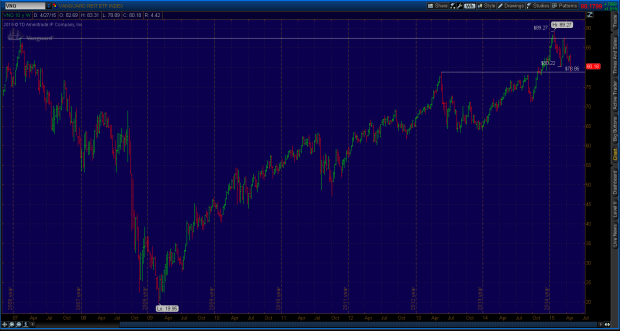
REITs or Real Estate Investment Trusts have been one of the best, if not the best performing asset class for some time. REITs are pooled investment vehicles that invest in real estate directly and allow individuals to invest in real estate in a liquid and affordable way. One of my favorite investment vehicles for REITs in the Vanguard REIT index ETF (VNQ). It’s one of the lowest costing vehicles for commercial real estate exposure.
The total return for VNQ since the March 2009 lows has been close to 350% while the S+P 500 has been around 219%. Of course the extra alpha comes with extra risks as this REIT ETF lost 77% of its value during the Great Recession and has just this year gotten back to the levels it was trading pre-crisis some 8 years ago. The just goes to show you that any legitimate investment opportunity is never immune to the risk to reward trade-off.
So as we see in the chart above, this year VNQ finally took out its 2007 highs. But it has since been under some selling pressure, even turning negative for year to date.

This next chart we can see the price action more clearly. Early this year the price makes a new all time high, unfortunately many individual investors see this as a time to put money in, when oftentimes markets correct after taking out important swing highs. I discuss this concept in the book in more detail. The correction that followed eventually matched the size of the prior correction in 2014 (approximately $8). Price eventually found support and rallied back to the 2007 high levels (#1-white horizontal line) where sellers took control once again.
Yesterday price found support at a previous swing high that coincided with a matching correction size of the first drop this year (#2). That first price drop in February saw price go from $89.27 to $80.22 ($9 points) while the drop from the lower high put in late March went from $87.61 to $78.86 yesterday.
It’s anyone’s guess whether this will be the end of the correction or not, REIT prices can be sensitive to changes in interest rates and future economic growth, or lack thereof. So in the case that support fails to hold in the $78 area, $75 would be the next logical downside target.

